Rival Spark research, done during the AI hype cycle of this year’s Cannes Festival of Creativity, asked marketers and consumers in the US and UK about their attitudes towards AI, its impact and its outputs. Rival’s co-founder DuBose Cole explores three key findings.
The age of Artificial Intelligence isn’t just upon us, it’s all around us – especially for those in advertising. However, beyond the hype and novelty of new AI technologies and applications exist questions about how consumers and marketers feel about it. Beyond the full report, we found three key takeaways for marketers thinking about approaching AI currently.
Advertising is already in the age of augmented creativity
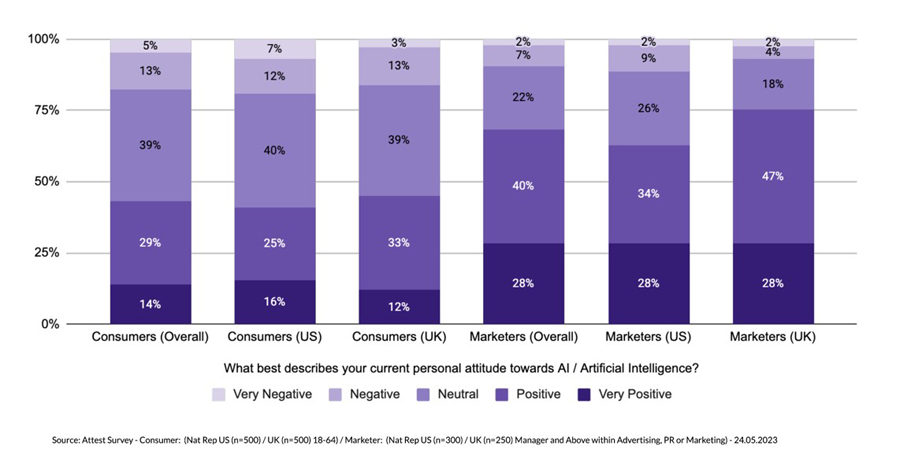
Consumers are wary but optimistic about AI, with our research showing 18% view the technology as negative and 43% see it as a positive or very positive thing. Marketers are even more optimistic, with 68% seeing it as a positive or very positive thing. This optimism exists despite 72% of marketers believing AI will change how they do their job and 52% believing it threatens their career.
The dissonance of positivity around AI and professional marketing potentially stems from the fact we’re already using it. Both consumers and marketers see advertising, and additionally finance, as the two areas where AI can match or exceed human performance currently – with the creation of digital ads, TV ads and personalized financial recommendations standing as the three strongest perceived outputs of the technology.
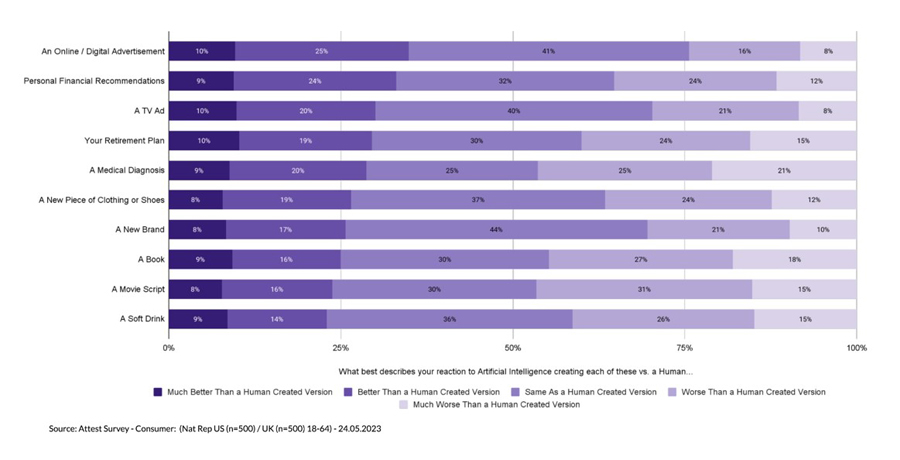
Our Rival Spark research shows over 70% of marketers and consumers believe that AI technology can create a digital or TV ad as well or better than a human can – highlighting an already-existing belief that the technology may have eclipsed the human abilities of the advertising industry by those that create ads and those consuming them. Alternatively, though over half of both audiences believed AI matched or exceeded human output, books and movie scripts were seen as the area where AI proved weakest – potentially highlighting a belief that more emotive creativity is an area where humans take the lead.
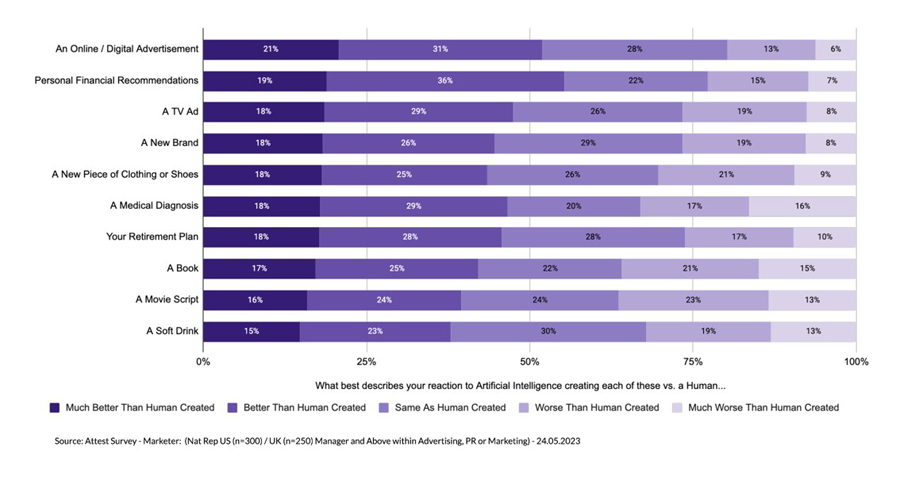
Regardless of attitudes towards specific outputs however, we find that both marketers and consumers already acknowledge a comparable ability to create in AI. However, we shouldn’t assume this means creative industries are out of a job tomorrow; instead, we have to find creative augmentation in technology – using this emerging field as many have already done to speed towards more unexpected, evocative and creative outputs than we could find on our own. To build on top of the emerging belief that technology can out-create us in certain situations must be met with the belief that we can stand on its shoulders to find new ways to build, instead of assuming our creative value is diminished.
The emotion gap: AI attitudes skew towards curation over creation of the things we love
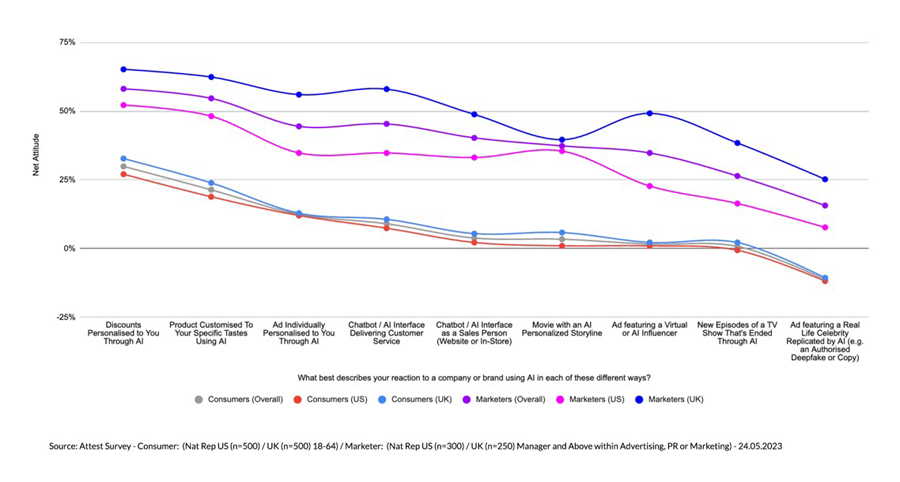
When considering consumer and marketer attitudes to a range of outputs, our research found that tailored ads, discounts and products, as well as conversational interfaces were most positively received. While we believe that AI can create a range of content, we’re least positive about its ability to create personalized movies, resurrect canceled TV shows with personalized episodes or make artificial human likeness.
The current Screen Actors Guild (SAG) and Writers Guild of America (WGA) strikes, as well as public reaction to experiments in content creation from Infinite Seinfeld to Showrunner AI’s artificially created South Park episode, highlight that just because we believe in increasing AI ability, AI appetites are still variable. We seemingly want to believe that the things we love and the emotions they evoke are the domain of other humans to stir, even if technology is rapidly advancing to challenge this.
The ability of AI to sell has been accepted and, as our data shows, is relatively positive – however emotive advertising and storytelling involving beloved characters and humans is going to be a minefield. As more than one marketer is potentially considering AI created Christmas ads in the UK or Super Bowl ads in the US right now, nuance and human editorial oversight will be persistent considerations.
Brands adapting to AI need to act like APIs
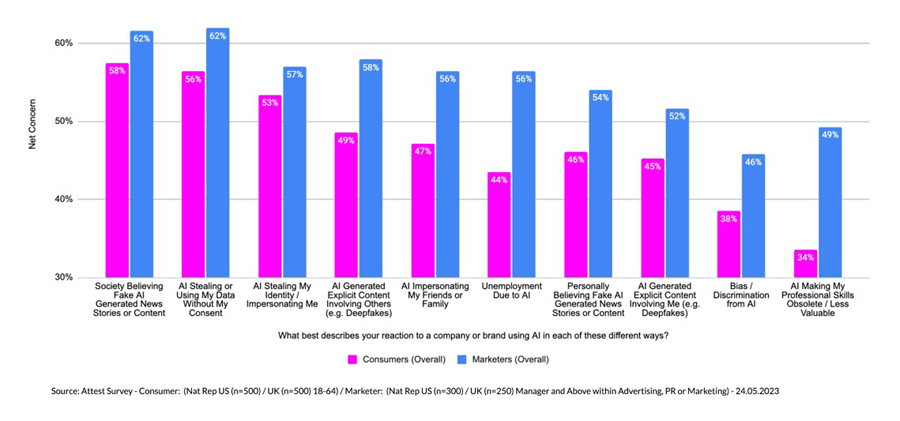
Our research shows that consumer and marketer fears around AI center on fake content, impersonation and ownership of both brand and personal image. In an age where anything is increasingly possible and created with ease, as creativity is augmented with technology, decreasingly less can be held as true quickly. The ability to police personal likeness or brand assets is a shared challenge for both consumers and marketers which technology will seemingly need time to catch up on. Intel’s recent Cannes success with its deepfake detection campaign, shows the opportunity for technology and content brands to help augment verification.
However, holding back the tide of augmented creation and the negative of fake content is increasingly unlikely on its own. Instead, working in concert with emerging verification technologies brands need to increase the availability of desired assets, outputs and content. We believe structuring how you go to market and interface with technology and culture in the coming years requires brands to think like Application Programming Interfaces or APIs.
APIs are all around us online, allowing developers to work within a structure to easily obtain, use and build experiences on top of data and content. APIs allow for freedom within a widely defined boundary and brands must adopt a similar ethos. Considering how different audiences in culture want to interface with a brand and how to serve the correct content is already a bedrock of culturally relevant brands.
As AI use increases, considering how to serve and structure brand assets and contents towards the AI platforms will become a differentiator for how the technology creates content within a brand. As the prominence of Gucci or Wes Anderson’s style within Midjourney illustrates, where prompts mentioning either have a very distinct identity applied to generated images – brands which use their identity to influence the models underpinning AI will have a better chance to maintain what they stand for in a sea of content generated about them. AI is guided by the data behind it and brands, as owners of swaths of content and data, have a unique opportunity to influence how they show up in many cases beyond online policing, if they can interface with this emerging technology correctly.
Rival’s full Rival Spark research report on Generative AI is available here.

